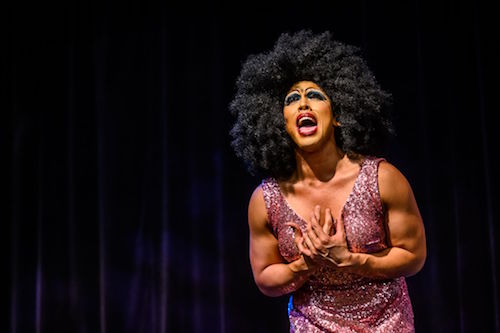
Tracey Erin Smith’s “Drag Heals” sits at the intersection of theatre and television, of drag and solo monologue performance. But then, the lines in drag have always been blurred, in a good way – here, we’re just blurring them a little more.
The performances at Buddies in Bad Times Theatre, a culmination of a five-week process, were shot to provide finale material for the second season of Smith’s TV show, produced by Border2Border Entertainment. The show began on a whim with documentary footage shot of her last class.
Smith, who runs the SOULO school of performance, which draws out participants’ stories in short monologue form, was inspired by a trip to a drag show at 2016 Pride. Reflecting on how difficult it was to get and hold an audience’s attention at the event – even with an abundance of glitz, glamour, and lip-synch – she wondered what it would be like if the performers were encouraged to tell their own stories while being their truest or most confident selves.
Although drag performance can be highly personal, at first glance it might seem to conflict with the genre of solo confessional performance. While drag plays outward, the monologue looks inward. While drag is larger than life, monologue is an individualized pinpoint to the heart. While drag creates a character, or “persona” with a different name, that can act like a shield between the outside world and the self, a personal story abandons all pretense, reveals the self, and makes one extremely vulnerable. Can these things coexist? Absolutely, Smith believes.
On the heels of successful reality TV like Drag Race, here the drag performances aren’t in competition with each other, and the point of the class is to grow closer to each other. The intent is in the title – drag not as a barrier, but as part of a healing process. The conceit is to explore not only one’s identity and test one’s boundaries in drag, but also to explore the value and meaning of the drag performance itself.
Smith has chosen a diverse group of eight performers, from kings and queens to all kinds of royalty. Some performers take on the more traditional opposite-gender drag, but some explore drag in the same gender – for example, a 45-year-old woman and mother experiments with hyperfeminized drag to explore her fear of makeup and to comment on her recent invisibility to society due to her age and children. For some, gender is fluid or nonexistent, and drag is a way to explore an aspect of personality and who you want to be, for a night or in the long run.
There are performers giving their first show to a live audience and performers who are long-practiced. There are racialized performers who comment on the notion of being required to perform race as well as gender, particularly when it comes to the entertainment world. There are singers, dancers, theatre artists turned drag performers and drag performers turned theatre artists and non-performers turned performers. There’s glam-rock and pop princes and princesses, Broadway babies, and alternative heroes.
Moreover, the audience is sharing in all of this, but performing too, as we’re the live studio audience being filmed for further consumption – as Smith puts it, the “midwives” to this birth of performance and identity. Strangely, or perhaps appropriately, this builds community with the performers, rather than distance.
Opening up what is extremely personal to a potential audience of everyone, as well as the cold eye of the camera, is a difficult thing to ask of new and vulnerable performers. Thankfully, the audience is the buffer between stage and streaming, ideally making the artists feel supported rather than exploited.
It’s an enjoyable, cathartic experience, with emotions running high and all over the place. Unlike much drag, where the point is to sustain loud cheering in a burst of excitement and joy, this is drag that often invites silent contemplation of pain – but also bursts of excitement and joy. Performers will often start and end with their drag personas, telling their stories in the middle, and linking them together into an argument for choosing to do drag.
One reads a letter to the drag self from the real-world self, outlining the difference between wanting to explore drag and wanting to “pass” as something you’re not. A sad clown literally inhabits a pad of drawing paper, which assists her in redesigning the world around her.
An older performer who was forced to live a lie for most of his life shares one of the most moving stories, twinning the process of putting on the trappings of drag with the process of fully coming into himself by coming out.
Themes recur: stories of mental illness, self-questioning and rejection from family members and society at large contrast with the open and welcoming environment of Buddies as they share their truths.
“This is the best version of me that has ever existed,” says performer Cyril Cinder. If the self can be constantly in flux and reach for something more, so can the idea of drag.
Details:
- Drag Heals was filmed at Buddies in Bad Times Theatre (12 Alexander St) on January 31 and February 1, 2020.
- Season One of Drag Heals is currently available on OutTV and Amazon Prime
- Season Two is coming soon!
Photo of Rosé Dior by Dahlia Katz
